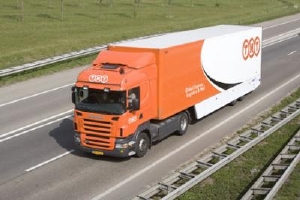Apr 17 2008
Creating an improved aerodynamic shape for truck trailers by mounting sideskirts can lead to a cut in fuel consumption and emissions of up to as much as 15%. Earlier promising predictions, based on mathematical models and wind tunnel tests by TU Delft, have been confirmed during road tests with an adapted trailer. This means that public-private platform PART (Platform for Aerodynamic Road Transport), has produced an application which can immediately be put into production.
 Creating an improved aerodynamic shape for truck trailers by mounting sideskirts can lead to a cut in fuel consumption and emissions of up to as much as 15%. Earlier promising predictions, based on mathematical models and wind tunnel tests by TU Delft, have been confirmed during road tests with an adapted trailer. (Credit: TNT Presslink)
Creating an improved aerodynamic shape for truck trailers by mounting sideskirts can lead to a cut in fuel consumption and emissions of up to as much as 15%. Earlier promising predictions, based on mathematical models and wind tunnel tests by TU Delft, have been confirmed during road tests with an adapted trailer. (Credit: TNT Presslink)
It is expected that the cost of fitting aerodynamically-shaped sideskirts will be recouped within two years. Furthermore, the sideskirts can be fitted to approximately half the trucks currently in use in the Netherlands as the skirts can also be retrofitted.
CO2 reduction
Prof. Michel van Tooren of TU Delft’s Aerospace Engineering faculty: “In 2005, 10,000 new trailers were taken into use in the Netherlands. With an average fuel consumption of 30 litres per 100 kilometres, that translates into 750 million litres of diesel consumption in the Netherlands each year. We can cut fuel consumption by 5% or more for 50% of those trailers. That means a reduction of 50 million tons of CO2 emissions a year. This research can therefore result in a substantial, structural contribution to cutting fuel consumption and an annual saving of tens of millions of Euros, next to that cut in CO2 emissions by the road transport sector.”
He continues: “Together with this sector we have created a practical platform for further research and development, but we still need active government participation. Just obtaining permits for all the road tests has involved a huge amount of time, energy and frustration. The next step is realizing a practical partnership between the government and industry in order to put the solutions into practice.”
PART
The objective of PART, a partnership between TU Delft, TNT, Scania Beers BV, FOCWA Carrosseriebouw, Ephicas, Kees Mulder Carrosserieën, Van Eck Carrosseriebouw, Syntens, Squarell Technology, Emons Group and NEA transport research and training, is to develop and test aerodynamic applications for trailers. In contrast to research into the aerodynamic properties of trucks, comparable research into trailers is still relatively new. Applications such as the Ephicas sideskirts or boat tails could lead to reductions in air resistance of up to 30%, which translates into a reduction in fuel consumption and emissions of as much as 15%. Moreover, it contributes to increasing profits in the highly competitive world of road transport.
Sideskirts
Sideskirts are plates which are mounted on the sides of trailers, primarily with a view to underrun protection. The new aerodynamic design of the sideskirts substantially reduces the air currents alongside and under the trailer and thereby also the air resistance. Initial driving tests with a trailer equipped with the aerodynamic sideskirts over a straight stretch of public road revealed a cut in fuel consumption of between 5% and 15%. Subsequent research comprising long-term operational tests by TNT displayed a fuel reduction of 10%. These results confirm the calculations and findings from the wind tunnel tests: these had already established that the observed 14 - 18% reduction in air resistance led to 7 - 9% less fuel consumption. In practice, the figures are in fact even better.
Boat Tail
Road tests have also already been initiated on what are known as boat tails. These constructions on the rear of a trailer ensure a reduction in the wake: the vacuum and air currents which arise when the trailer is moving. In theory, a boat tail could also mean a cut in air resistance of 30%, with a fuel reduction of 10 - 15%. These road tests should also confirm the earlier, highly positive results from the windtunnel.
Incidentally, this study does not aim to produce boat tails for commercial use. Limitations in their practical use, in particular when loading and unloading, safety aspects and problems with exceeding maximum vehicle sizes prevent these being used for many types of vehicles. This research focuses on gaining knowledge and developing different practicable solutions; the second development phase will concentrate on these aims.